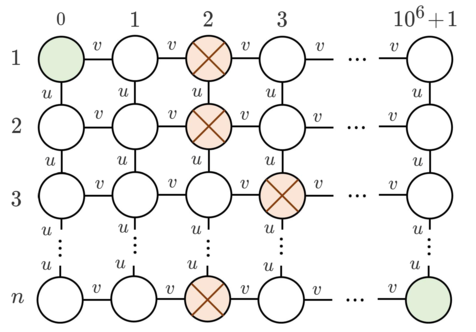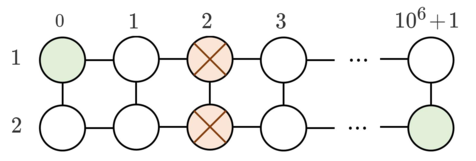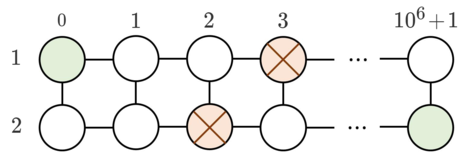CF1491B.Minimal Cost
普及/提高-
通过率:0%
AC君温馨提醒
该题目为【codeforces】题库的题目,您提交的代码将被提交至codeforces进行远程评测,并由ACGO抓取测评结果后进行展示。由于远程测评的测评机由其他平台提供,我们无法保证该服务的稳定性,若提交后无反应,请等待一段时间后再进行重试。
题目描述
There is a graph of n rows and 106+2 columns, where rows are numbered from 1 to n and columns from 0 to 106+1 :
 Let's denote the node in the row i and column j by (i,j) .
Let's denote the node in the row i and column j by (i,j) .
Initially for each i the i -th row has exactly one obstacle — at node (i,ai) . You want to move some obstacles so that you can reach node (n,106+1) from node (1,0) by moving through edges of this graph (you can't pass through obstacles). Moving one obstacle to an adjacent by edge free node costs u or v coins, as below:
- If there is an obstacle in the node (i,j) , you can use u coins to move it to (i−1,j) or (i+1,j) , if such node exists and if there is no obstacle in that node currently.
- If there is an obstacle in the node (i,j) , you can use v coins to move it to (i,j−1) or (i,j+1) , if such node exists and if there is no obstacle in that node currently.
- Note that you can't move obstacles outside the grid. For example, you can't move an obstacle from (1,1) to (0,1) .
Refer to the picture above for a better understanding.
Now you need to calculate the minimal number of coins you need to spend to be able to reach node (n,106+1) from node (1,0) by moving through edges of this graph without passing through obstacles.
输入格式
The first line contains a single integer t ( 1≤t≤104 ) — the number of test cases.
The first line of each test case contains three integers n , u and v ( 2≤n≤100 , 1≤u,v≤109 ) — the number of rows in the graph and the numbers of coins needed to move vertically and horizontally respectively.
The second line of each test case contains n integers a1,a2,…,an ( 1≤ai≤106 ) — where ai represents that the obstacle in the i -th row is in node (i,ai) .
It's guaranteed that the sum of n over all test cases doesn't exceed 2⋅104 .
输出格式
For each test case, output a single integer — the minimal number of coins you need to spend to be able to reach node (n,106+1) from node (1,0) by moving through edges of this graph without passing through obstacles.
It can be shown that under the constraints of the problem there is always a way to make such a trip possible.
输入输出样例
输入#1
3 2 3 4 2 2 2 3 4 3 2 2 4 3 3 2
输出#1
7 3 3
说明/提示
In the first sample, two obstacles are at (1,2) and (2,2) . You can move the obstacle on (2,2) to (2,3) , then to (1,3) . The total cost is u+v=7 coins.
 In the second sample, two obstacles are at (1,3) and (2,2) . You can move the obstacle on (1,3) to (2,3) . The cost is u=3 coins.
In the second sample, two obstacles are at (1,3) and (2,2) . You can move the obstacle on (1,3) to (2,3) . The cost is u=3 coins.
